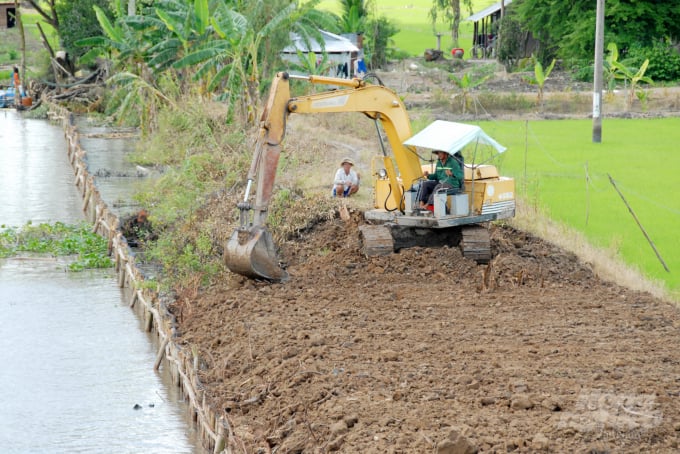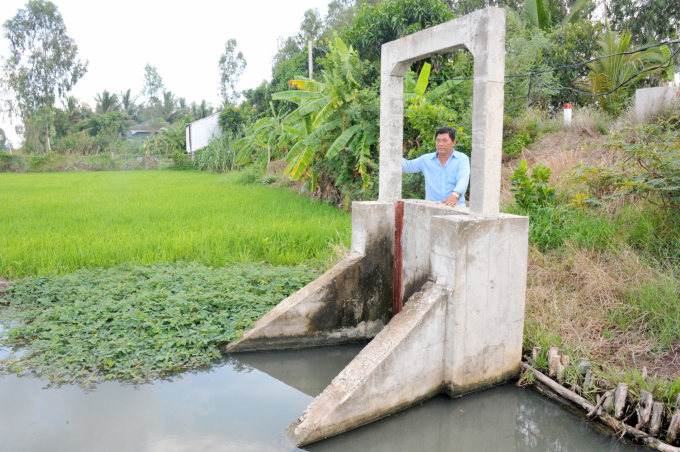December 31, 2025 | 16:27 GMT +7
December 31, 2025 | 16:27 GMT +7
Hotline: 0913.378.918
December 31, 2025 | 16:27 GMT +7
Hotline: 0913.378.918

Annually, Dong Thap province strives to maintain, upgrade, repair, and build new irrigation systems to ensure irrigation for production on 554,799 hectares of cultivated area. Photo: Le Hoang Vu.
Acknowledging that irrigation systems play an important role in agricultural production, in order to improve the ability to mitigate and adapt to climate change to ensure sustainable development in the agricultural and rural sectors. To achieve this, for many years, Dong Thap Provincial People's Committee made a planning proposal to the Central Government focusing on investment goals, upgrading the irrigation system, gradually completing and modernizing the shaft system from the main canal to infield canal, meeting the requirements for crops and livestock restructuring... to exploit and manage water resources effectively, sustainably and adapt to climate change.
Mr. Huynh Minh Tuan, Vice Chairman of Dong Thap Provincial People's Committee said that Dong Thap province's has an open irrigation system with interwoven canals, water is taken from Tien and Hau rivers through horizontal canals, supplied to vertical canals, channels, leading into the in-field canal network for direct irrigation or irrigation pumping used in production. The province's summer-autumn rice crop in 2021 reached nearly 200,000 hectares, and crops of all kinds reached about 19,500 hectares with water ensured by the exceptional irrigation system in the fields.
Annually, Dong Thap province spends over 500 billion VND to maintain, upgrade, repair, and build new
Dong Thap province has 833 constructions of axis canals, grade II, III and IV canals with a length of about 4,073 km, a service area of about 485,132 ha, a regulation system with 2,616 various culverts and 1,219 electric pumping stations. Regarding production protection plots, the whole province has 1,319 production plots, with a length of 8,105 km. 1,102 of which are completely enclosed plots, with a length of 6,303 km, 217 anti-flood plots (protecting autumn-winter rice).
irrigation systems, ensuring irrigation for production on 554,799 hectares of cultivated area.
According to Mr. Tuan, to help the irrigation system serve agriculture in the province better towards 2025, about 350 billion VND is needed to upgrade the irrigation works system for advanced and water-saving irrigation, electric pumping station, sewer. At the same time, reinforce canals to meet the requirements of agricultural restructuring in the province, associated with new rural construction in the province.
Additionally, it has received the attention and support of the Ministry of Agriculture and Rural Development, central departments and agencies, and with its reciprocal capital, Dong Thap province will implement 11 projects with a budget of about 1,500 billion (the central government will support 950 billion VND) for the construction of embankments to protect the banks of the Tien River in key and densely populated locations, (Binh Thanh embankment, Ho Cu embankment in Hoa An commune, Sa Dec embankment, An Hiep embankment) and fisheries infrastructure. The completed projects are put into effective use and in a timely manner, ensuring the safety of lives, houses, land, stabilizing people's lives, contributing to the development of the local economy.
In Thap Muoi district (Dong Thap), with its strength in developing aquaculture and rice cultivation, proactive water source is very important for the district agricultural production in both the dry and the flood season. Mr. Tran Van Khiem, from Lang Bien commune, said: Irrigation works for storing and proactively irrigating water for agricultural production are of high interest and invested by local authorities to develop production. In recent years, despite having to face severe drought or floods at times, the fish ponds and fields of his family and other households have been maintained and developed quite well thanks to the ensured water safety and convenient access helps local farmers develop smoothly for many years.

Dong Thap is promoting investment and upgrading the field irrigation system towards modernization, to meet the requirements of crops and livestock restructuring... Photo: Le Hoang Vu.
Mr. Bui Van Son, Head of the Department of Agriculture and Rural Development of Thap Muoi district, said: For many years, communes have aimed for targets such as dredging canals, reinforcing sluices, dams and embankments, clearing grass, building new rural traffic in combination with irrigation... and the district develops plans for implementation.
Along with that, excel in the extensive propaganda work to raise people's awareness about the contents, methods, mechanisms and policies of the State in the process of implementation. Additionally, the use of resources for public works must be democratically and unanimously discussed by the people, with community supervision, ensuring publicity and transparency. Thereby, the Campaign has brought practical effects. The irrigation system in the district has been fundamentally completed, promoting the development of agricultural production, gradually forming large and specialized production areas.
Translated by Nguyen Hai Long

(VAN) From extensive shrimp ponds, baskets of don gathered on the mudflats, to boats carrying visitors to watch birds, all livelihoods here depend on clean water, green forests, and the calls of migratory birds.
/2025/12/26/0703-3-204813_117.jpg)
(VAN) Transparency in information and listening to local people have helped address ground clearance bottlenecks and build social consensus, thereby accelerating the progress of the JICA3 irrigation project.
/2025/12/27/0609-3-233846_327.jpg)
(VAN) The JICA3 project is expected to become a 'water shield,' helping control saltwater intrusion, proactively secure water resources, protect livelihoods, and promote sustainable development in coastal areas.
/2025/12/26/5654-3-164509_655.jpg)
(VAN) As Viet Nam makes strong commitments toward achieving net-zero emissions, controlling and reducing methane emissions in livestock production is increasingly becoming a mandatory requirement.

(VAN) 'People, Primates, Plants: Co-managing Biodiversity and Improving Livelihoods in Vietnam' (the PPP Project) is an international initiative implemented in Vietnam by BGCI, CEGORN, and ICRAF/World Agroforestry.

(VAN) Dak Nong established a risk-level zoning map for coffee, built a digital data platform for the sector, and promoted certified production in line with EUDR.
/2025/12/25/2709-1-211551_295.jpg)
(VAN) In response to the U.S. Marine Mammal Protection Act (MMPA), Gia Lai province is implementing many solutions to protect marine mammals and develop sustainable, responsible fisheries.